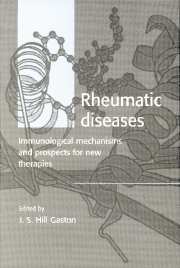Book contents
- Frontmatter
- Contents
- List of contributors
- 1 Implications of advances in immunology for understanding the pathogenesis and treatment of rheumatic disease
- 2 The role of T cells in autoimmune disease
- 3 The role of MHC antigens in autoimmunity
- 4 B cells: formation and structure of autoantibodies
- 5 The role of CD40 in immune responses
- 6 Manipulation of the T cell immune system via CD28 and CTLA-4
- 7 Lymphocyte antigen receptor signal transduction
- 8 The role of adhesion mechanisms in inflammation
- 9 The regulation of apoptosis in the rheumatic disorders
- 10 The role of monokines in arthritis
- 11 T lymphocyte subsets in relation to autoimmune disease
- 12 Complement receptors
- Index
12 - Complement receptors
Published online by Cambridge University Press: 06 September 2009
- Frontmatter
- Contents
- List of contributors
- 1 Implications of advances in immunology for understanding the pathogenesis and treatment of rheumatic disease
- 2 The role of T cells in autoimmune disease
- 3 The role of MHC antigens in autoimmunity
- 4 B cells: formation and structure of autoantibodies
- 5 The role of CD40 in immune responses
- 6 Manipulation of the T cell immune system via CD28 and CTLA-4
- 7 Lymphocyte antigen receptor signal transduction
- 8 The role of adhesion mechanisms in inflammation
- 9 The regulation of apoptosis in the rheumatic disorders
- 10 The role of monokines in arthritis
- 11 T lymphocyte subsets in relation to autoimmune disease
- 12 Complement receptors
- Index
Summary
Complement receptor type 1
The primary function of complement receptor (CR) type 1 (CR1, CD35) is phagocytosis and clearance of immune complexes, which is mediated by its capacity to bind complement ligands C3b, iC3b, C4b and C1q and its capacity to inactivate the C3 and C5 convertases of the alternative and classical complement pathways through decay-accelerating and cofactor functions (Fearon, 1979; Iidia & Nussenzweig, 1981; Medof et al., 1982; Klickstein et al., 1997). CR1 is expressed primarily by haematopoietic cells, including erythrocytes, mononuclear phagocytes, eosinophils, B lymphocytes and T lymphocytes. It is also present on glomerular podocytes and follicular dendritic cells (Fearon, 1980; Wilson, Tedder & Fearon, 1983; Gelfand, Frank & Green, 1975; Kazatchkine et al., 1982; Reynes et al., 1985).
Structurally, CR1 is a type I transmembrane glycoprotein (Fig. 12.1). Four CR1 allotypes have been identified (Dykman et al., 1983a,b; 1985; Wong, Wilson & Fearon, 1983; Dykman, Hatch & Atkinson, 1984), with Mr under reducing/non-reducing conditions of ∼250 000/190 000 (A, F), 290 000/220 000 (B, S), 210 000/160 000 (C, F′) and >290 000/250 000 (D) (Wong & Fearon, 1987). All CR1 allotypes share the same transmembrane domain of 25 amino acid residues and a 43 residue cytoplasmic tail. All allotypes have extracytoplasmic domains composed entirely of structural motifs, referred to as short consensus repeats (SCR), or complement control protein (CCP) modules, arranged in tandem. The A(F) allotype comprises 2039 residues, including a 41 residue signal peptide and a 1930 residue extracellular domain composed entirely of 30 SCRs (Klickstein et al., 1988; Hourcade et al., 1988). The amino terminal 28 SCRs are arranged in four long homologous repeats (LHRs) (A–D) of seven SCRs each; two additional SCRs link LHR-D with a 25 residue transmembrane region and a 43 residue cytoplasmic domain (Klickstein et al., 1988).
- Type
- Chapter
- Information
- Rheumatic DiseasesImmunological Mechanisms and Prospects for New Therapies, pp. 245 - 276Publisher: Cambridge University PressPrint publication year: 1999



